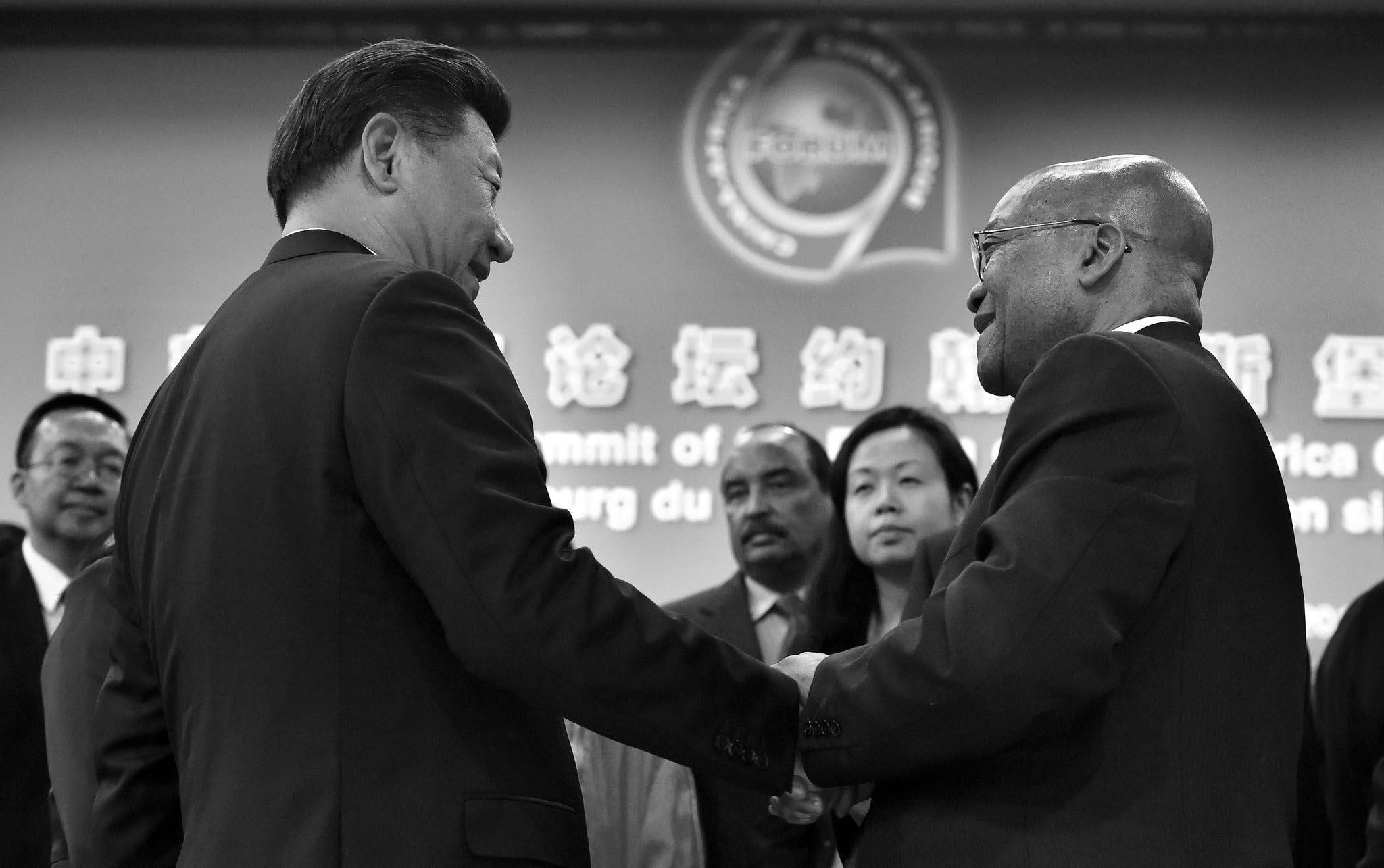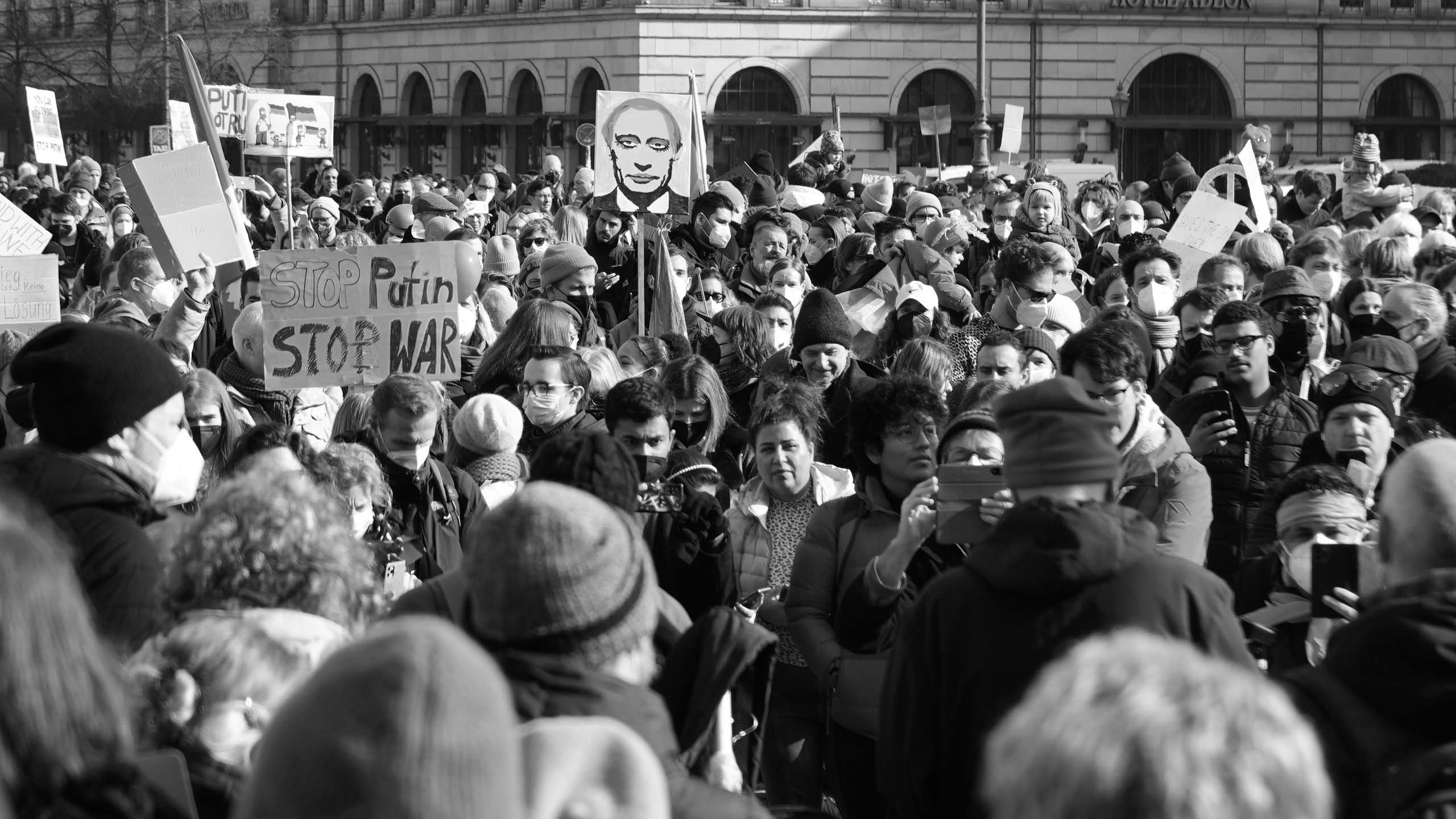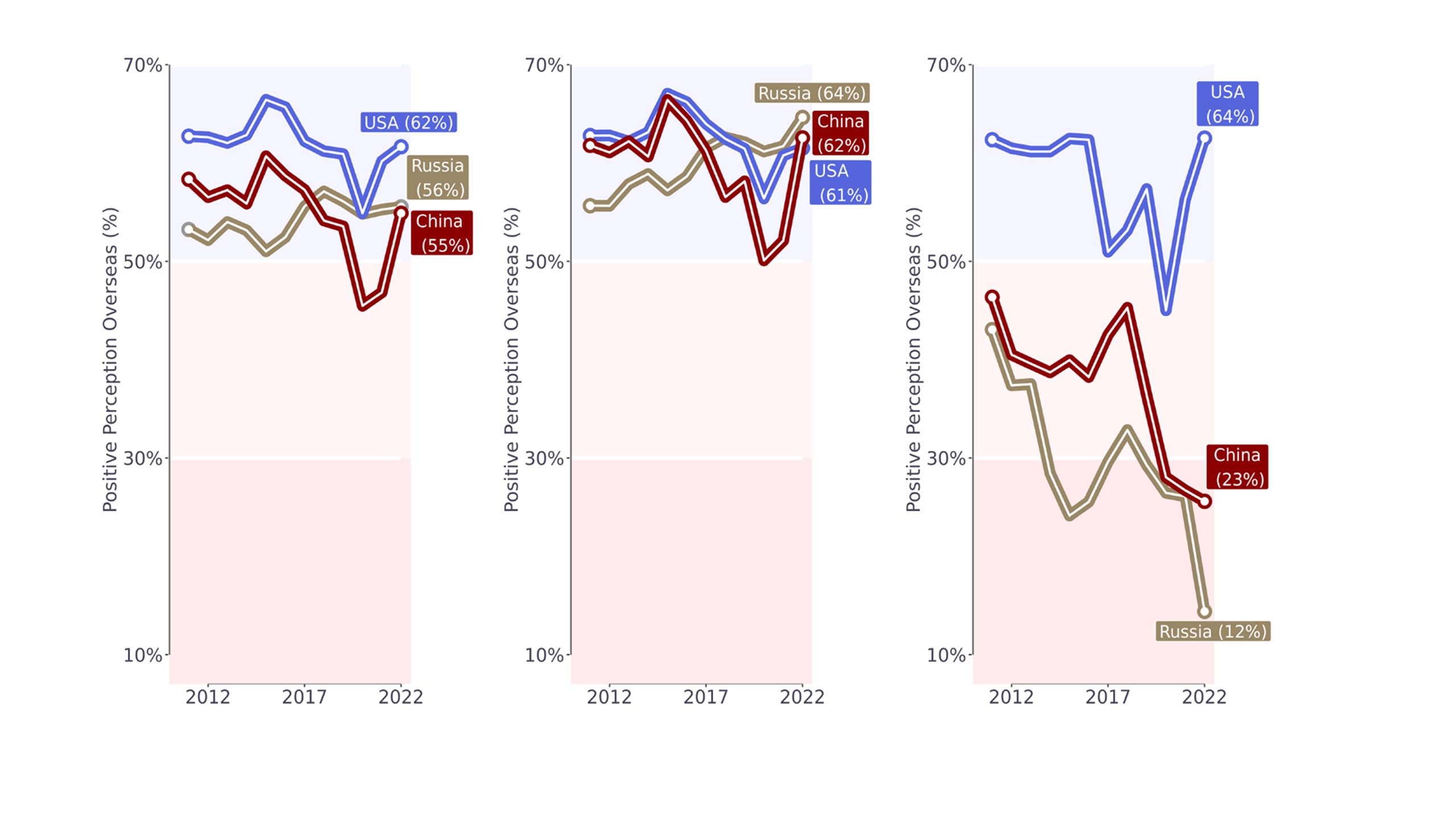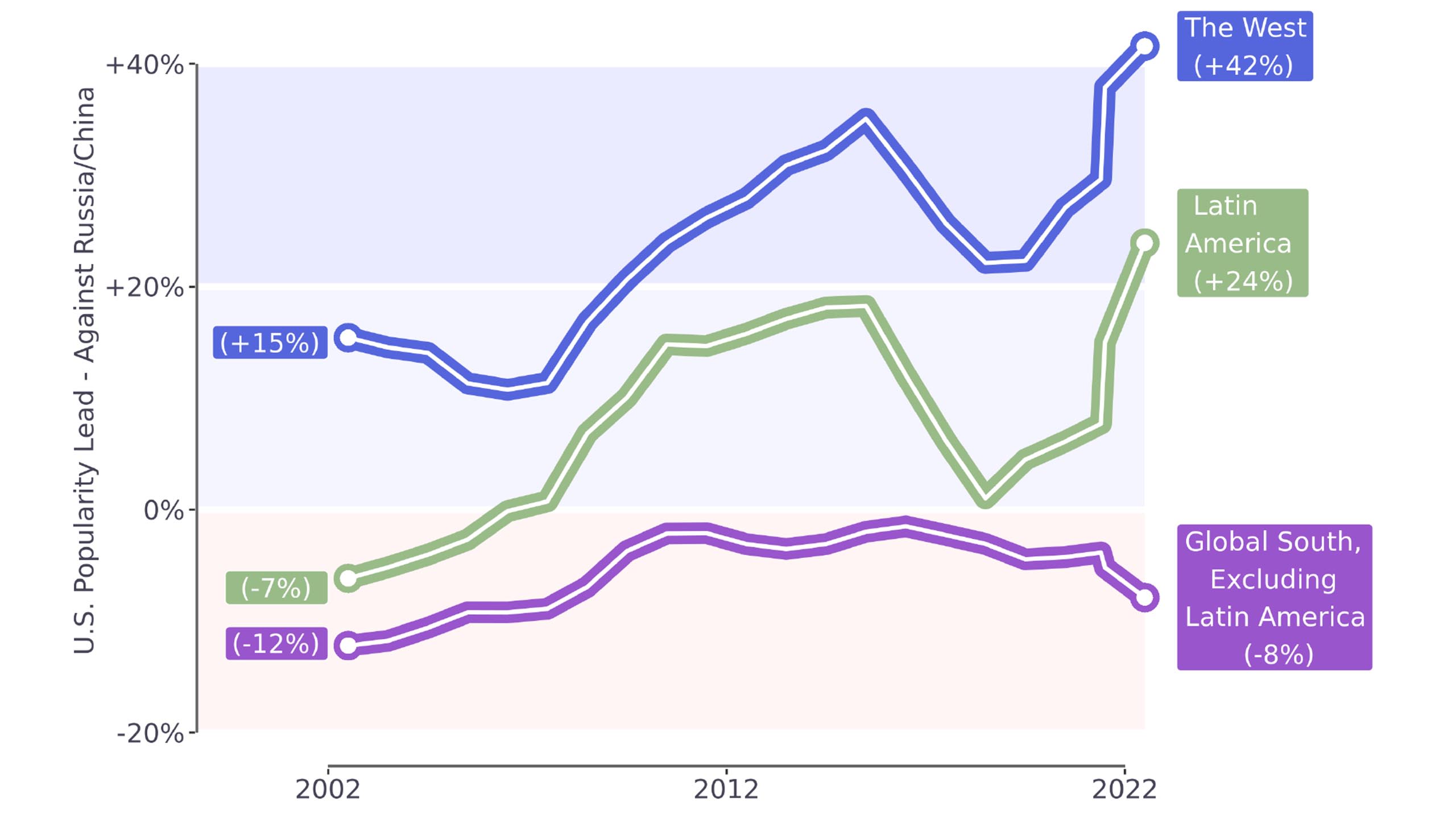風蕭蕭_Frank
以文會友烏克蘭戰爭擴大了全球公眾對美國、中國和俄羅斯態度的分歧
https://www.cam.ac.uk/stories/worlddivided
弗萊德·盧西
“世界已分為自由領域和非自由領域”
澤維爾·羅梅羅-維達爾博士
在世界各地,公眾對國際政治的態度正在凝聚成兩個對立的陣營:支持美國的自由民主國家和支持中國和俄羅斯的威權國家公民 — — 烏克蘭戰爭加速了這一進程。
這是劍橋大學研究人員的說法,他們“統一”了在137個國家(其中包括自 2022 年 2 月俄羅斯襲擊烏克蘭以來的75個國家)進行的調查數據,發現了一種鴻溝(持續了十年),導致全球人口兩極分化。
他們說,俄羅斯的戰爭讓西方人民對美國和北約更加忠誠,並使拉丁美洲和東歐的富裕民主國家采取了親美立場。
然而,報告也指出了一個不自由和不民主社會的區域,從東亞穿過中東一直延伸到西非,其特點是完全相反的趨勢:近年來,人們對中國、俄羅斯或兩者的支持穩步增加。 年。
根據該大學未來中心今天發布的報告,在世界自由民主國家的 12 億人口中,四分之三 (75%) 的人對中國持負麵看法,87% 的人對俄羅斯持負麵看法 民主(CFD)。
然而,在世界上其餘136個國家的63億人口中,情況恰恰相反——70%的人對中國持積極態度,66%的人對俄羅斯持積極態度。
該分析包括來自新興經濟體和全球南方國家的重要民意數據,並表明這種分歧不僅是經濟或戰略上的,而且基於個人和政治意識形態。
報告合著者、劍橋貝內特公共政策研究所的澤維爾·羅梅羅-維達爾博士表示:“世界已分為自由領域和非自由領域。”
“今天的全球鴻溝並不那麽依賴於國家之間的曆史聯係。 我們發現,衡量世界各地社會地緣政治協調程度的最有力指標是其基本價值觀,例如言論自由。”
海事與歐亞集團
新鴻溝的一側是研究人員所說的“海洋聯盟”,其原則基於貿易和思想自由流動以及保護個人權利。
這些國家包括歐洲大部分地區以及美洲和澳大利亞更穩定的地區。 盡管受到特朗普總統任期的幹擾,他們的北極星仍然主要是美國。
對立的集群以中國和俄羅斯為核心的“歐亞集團”為中心,橫跨歐亞大陸與中亞、伊朗和阿拉伯中東以及非洲和東南亞的大部分地區都有聯係。
研究人員表示,與冷戰時代的一些比較仍然成立,因為後一個群體廣泛團結在拒絕“西方現代性”和自由主義價值觀上。

南非總統雅各布·祖馬與中國國家主席習近平在2015年中非合作論壇閉幕式上共享輕鬆時刻。
劍橋貝內特研究所 CFD 聯席主任、合著者羅伯托·福阿 (Roberto Foa) 博士表示:“高收入民主國家已經變得更加世俗化,更願意接受少數群體的權利,但世界其他地區卻沒有。”
“像普京這樣的獨裁者利用這個機會將自己描繪成他們所謂的‘傳統’價值觀的捍衛者,以應對西方自由主義的威脅。”
對烏克蘭的戰爭“加劇”了這種分歧,但調查結果表明,這種分歧已經醞釀了十年,因為十年前,全球公眾對地緣政治的看法更加複雜和不確定。
研究人員認為,中國的自信和跨國基礎設施投資以及中國和俄羅斯對非洲的戰略重點都有助於改變局麵。
福阿說:“俄羅斯的戰爭導致全球分歧加劇,現在劃定的戰線反映了自由主義和威權主義的兩麵。”
“如果我們觀察世界各地不同人群對俄羅斯的看法,我們會發現他們的政府在外交上對待俄羅斯的方式幾乎是相同的。”
“民主和言論自由是混亂的,即使是最成熟的民主國家近年來也證明了這一點”
羅伯托·福阿博士
過去十年全球輿論對俄羅斯、中國和美國的趨勢。 在全球範圍內,美國仍然領先於中國和俄羅斯。 然而,這掩蓋了發達國家和發展中國家之間的重大分歧。 在其他西方國家,美國的相對好感度已飆升至新高,盡管俄羅斯和中國在南半球國家中已經超越。
中國、俄羅斯和美國——全球態度數據
報告發現,十年來俄羅斯一直在失去西方極端分子的“邊緣”支持。 截至 2022 年入侵烏克蘭前夕,對俄羅斯持積極看法的西方公民比例已從五分之二 (39%) 降至不到四分之一 (23%),目前僅為八分之一( 12%)。
與此同時,希臘(69%至30%)、匈牙利(45%至25%)或意大利(38%至14%)等以前同情俄羅斯的歐洲國家的公眾對俄羅斯的積極性大幅下降。
然而,在發展中國家地區,俄羅斯仍然受到青睞。 其中 75% 的受訪者來自南亞,68% 的受訪者來自非洲法語區,62% 的受訪者來自東南亞。
事實上,盡管發生了 2022 年的入侵,巴基斯坦、沙特阿拉伯和馬來西亞以及印度和越南對俄羅斯的公眾輿論仍然持積極態度。
同樣,現在西方對中國的態度也與其他國家產生了分歧。 就在五年前,五分之二(42%)的西方公民對中國持積極看法,這一數字幾乎減少了一半(23%)。
然而,在經曆了新冠疫情造成的下滑之後,中國在發展中國家的受歡迎程度有所回升,尤其是在參與龐大“一帶一路”倡議的147個國家的46億人中,其中近三分之二的人對中國持積極看法 ,而非參與國家隻有四分之一 (27%)。
一個主要的例外似乎是拉丁美洲,與其他發展中國家地區相比,該地區的受訪者現在對美國的支持度比中國高出創紀錄的 24%。599
雖然南半球大部分地區在美國和中國或俄羅斯之間保持中立,但拉丁美洲是一個主要例外 — — 人們對該地區北方鄰國的相對積極情緒達到曆史新高。
對民主的不滿
新的斷層線很大程度上源於對民主的態度。 “民主社會對俄羅斯和中國的態度要消極得多,而對於更專製的社會則相反。 這種關聯在十年前並不存在,但在今天卻非常明顯,”羅梅羅-維達爾說。
然而,一些選舉民主國家對俄羅斯和中國高度積極。 這些國家都在與腐敗和民主合法性作鬥爭,例如印度尼西亞、印度和尼日利亞。
事實上,在大多數人對俄羅斯持好感的國家中,有 69% 的人對民主表示不滿。 此外,在所有對民主不滿占多數的國家中,四分之三(73%)的公眾對中國也持積極態度。
“人們認為的民主缺陷與公眾對俄羅斯和中國的接受度提高有關。 民主和言論自由是混亂的,即使是最成熟的民主國家近年來也證明了這一點,”福阿補充道。
“中國提供了一種專製現代化的模式,在這種模式中,為了經濟增長和國家威望的承諾而放棄個人自由。
“中國與美國的相對吸引力可能不僅僅是美國作為盟友的吸引力問題,而是作為政治模式的問題。”
War in Ukraine has widened a global divide in public attitudes toward US, China and Russia
https://www.cam.ac.uk/stories/worlddivided
Story: Fred Lewsey

“The world has divided into liberal and illiberal spheres”
Dr Xavier Romero-Vidal
Around the world, public attitudes toward international politics are coalescing into two opposing blocks: liberal democracies favouring the United States and citizens of more authoritarian nations who back China and Russia – a process accelerated by the war in Ukraine.
This is according to University of Cambridge researchers, who “harmonised” data from surveys conducted in 137 countries, including in 75 countries since Russia attacked Ukraine in February 2022, and found a divide – growing for a decade – that now polarises the global population.
They say that Russia’s war has led people in the West to feel ever greater allegiance to both the US and NATO, and brought wealthier democracies in Latin America and Eastern Europe towards a pro-American stance.
However the report also identifies a zone of illiberal and undemocratic societies, stretching from East Asia through the Middle East and out towards West Africa, characterised by the exact opposite trend: populations that have steadily increased support for China, Russia, or both, in recent years.
Among the 1.2 billion people who inhabit the world’s liberal democracies, three-quarters (75%) now hold a negative view of China, and 87% a negative view of Russia, according to the report, published today by the University’s Centre for the Future of Democracy (CFD).
Yet among the 6.3 billion who live in the world’s remaining 136 countries, the opposite is the case – with 70% of people feeling positively towards China and 66% towards Russia.
The analysis includes significant public opinion data from emerging economies and the Global South, and suggests this divide is not just economic or strategic but based in personal and political ideology.
“The world has divided into liberal and illiberal spheres,” said report co-author Dr Xavier Romero-Vidal, from Cambridge’s Bennett Institute for Public Policy.
“Today’s global divide does not depend as much on historic ties between nations. The strongest indicators we found for how societies across the world align geopolitically are their fundamental values, such as freedom of expression.”
Maritime vs Eurasian Bloc
On one side of the new divide are what researchers call the “maritime alliance”, with principles based in free flows of trade and ideas, and the protection of individual rights.
These countries include much of Europe and more stable parts of the Americas and Australasia. Their lodestar is still primarily the US, despite the disturbance of the Trump presidency.
The opposing cluster is centred on a “Eurasian Bloc” anchored by China and Russia, with links across the continent to Central Asia, Iran and the Arab Middle East, as well as large parts of Africa and Southeast Asia.
Researchers say that some comparisons to the Cold War era still hold, as this latter group is broadly united in a rejection of “western modernity” and liberal values.

President Jacob Zuma of South Africa and President Xi Jinping of China share a light moment during the closing ceremony of Forum on China-Africa Cooperation in 2015.
“High-income democracies have become steadily more secular and receptive to minority rights, but the rest of the world has not,” said co-author Dr Roberto Foa, co-director of the CFD at Cambridge’s Bennett Institute.
“Autocrats such as Putin have taken the opportunity to present themselves as defenders of what they call ‘traditional’ values against a perceived threat of western liberalism.”
The war on Ukraine has “galvanised” this divide, but the findings suggest it has been a decade in the making, as global public opinion on geopolitics was far more mixed and undefined ten years ago.
The researchers argue that China’s assertiveness and transnational infrastructure investments have helped shift the dial, as well as both China and Russia’s strategic focus on Africa.
“Russia’s war has caused this global divide to intensify, as literal battle lines are now drawn that reflect the two sides of liberal freedoms and authoritarianism,” said Foa.
“If we look at how different populations around the world feel towards Russia, we find an almost identical reflection of how their governments have handled the country diplomatically.”
"Democracy and free expression are messy, as even the most established democracies have demonstrated in recent years"
Dr Roberto Foa

Trends in global public opinion towards Russia, China and the United States over the course of the past decade. Globally, the United States has retained its popularity lead over China and Russia. However, this masks a major divergence between developed and developing countries. In fellow western countries, America’s relative favourability has soared to newfound highs, though Russia and China have overtaken in the Global South.
China, Russia and the US – global attitude data
The report finds that Russia has been losing its “fringe” support among extremists in the West for a decade. The proportion of western citizens with a positive view of Russia had already fallen from two in five (39%) to less than a quarter (23%) by the eve of the 2022 invasion of Ukraine, and now stands at just one in eight (12%).
Meanwhile, public positivity toward Russia has plummeted in formerly sympathetic European countries such as Greece (69% to 30%), Hungary (45% to 25%) or Italy (38% to 14%).
In developing country regions, however, Russia is still viewed favourably. This includes 75% of respondents in South Asia, 68% in Francophone Africa, and 62% in Southeast Asia.
In fact, despite the 2022 invasion, public opinion of Russia remains positive in Pakistan, Saudi Arabia and Malaysia, as well as both India and Vietnam.
Similarly, attitudes to China now split the West from the rest. Just five years ago, two in five (42%) western citizens held a positive view of China, a figure that has almost halved (23%).
However, after a Covid-related dip, China’s popularity in the developing world has rebounded, especially among the 4.6 billion people in 147 countries participating in the colossal “Belt and Road Initiative” – among whom almost two-thirds hold a positive view of China, compared to just a quarter (27%) in non-participating countries.
The one major exception appears to be Latin America, where – in contrast to other developing country regions – respondents now favour the United States over China by a record 24% point lead.

While much of the global south remains neutral between the United States and China or Russia, Latin America stands out as the major exception – with relative positive feelings towards the region’s northern neighbour reaching record highs.
Dissatisfaction with democracy
Much of the new fault line is rooted in attitudes towards democracy. “Democratic societies are far more negative towards Russia and China, whereas the reverse is true for more authoritarian societies. This association did not exist a decade ago, yet is quite clear today,” said Romero-Vidal.
However, a number of electoral democracies are highly positive about Russia and China. These are nations struggling with corruption and democratic legitimacy, such as Indonesia, India and Nigeria.
In fact, dissatisfaction with democracy is a majority view in 69% of the countries in which most people feel favourably toward Russia. Moreover, out of all nations in which dissatisfaction with democracy is a majority view, three-quarters (73%) also have publics who are positive about China.
“Perceived democratic shortcomings are associated with greater public receptivity towards Russia and China. Democracy and free expression are messy, as even the most established democracies have demonstrated in recent years,” added Foa.
“China offers a model of authoritarian modernisation in which personal liberties are forsaken for the promise of economic growth and national prestige.
“The relative appeal of China versus the United States may not simply be a question of America’s attractiveness as an ally, but as a political model.”




